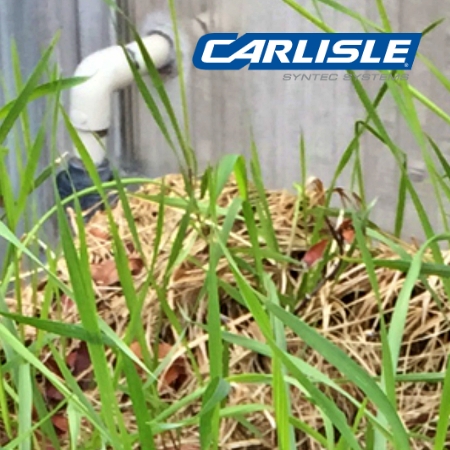By Chris Kann, Carlisle Product Manager
When installing overburden on a roof, it is extremely important to protect the underlying membrane. Physical damage can be caused by tradesmen during the installation, as well as by the overburden materials themselves.
Root barriers are a protection product that may be required for some green roof installations. Root barriers create an impenetrable protective barrier for the roof membrane against damaging root and rhizome systems that exist with many vegetation types. Root barriers are often required for semi-intensive or intensive green roof installations when vegetation other than sedum is used.
ANSI/GRHC/SPRI VR-1 “Procedure for Investigating Resistance to Roof Penetration on Vegetated Roofs” is the test procedure for determining if a material qualifies as an effective root and rhizomes barrier. The test requires nine trial containers to be constructed – six of which will be lined with the membrane being tested, and three control containers without membrane to be tested concurrently. The six test containers are lined with the membrane following specific installation instructions outlined in the testing procedure, which require multiple seams and corners as well as a T-joint.
The six trial and three control containers are then filled with growing media and very specific plants that are known to feature fast-growing, intrusive, and damaging root and rhizome systems. The vegetation used is Pyracantha coccinea, known as “orange charmer” and Elymus repens, known as “quack grass”. The test containers are then placed in a climate-controlled greenhouse for 24 months to ensure active and complete plant growth. At the end of the 24 months, the ground biomass will be removed and the containers will be evaluated for root or rhizome penetration – either through the membrane itself or through the joints or seams.
VR-1 testing has shown that seams are often the weak point in physical root barrier systems. Thermoplastic membranes’ heat-welded seams tend to exhibit superior root and rhizome resistance compared to taped seams. Heat-welded seams are more effective in preventing root and rhizome penetration due to the fusion bond that is created between adjoining sheets, which creates a monolithic membrane.
For more information on root barrier testing, you can access the ANSI/GRHC/SPRI VR-1 test procedure.
To learn more about Carlisle’s VR-1 tested and passed Root Barrier, you can view the product data sheet on the Carlisle SynTec website.
 Greenroofs.comConnecting the Planet + Living Architecture
Greenroofs.comConnecting the Planet + Living Architecture



